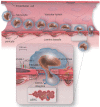Monocyte trafficking across the vessel wall
- PMID: 25990461
- PMCID: PMC4592323
- DOI: 10.1093/cvr/cvv147
Monocyte trafficking across the vessel wall
Abstract
Monocytes fundamentally contribute to immune surveillance and the inflammatory response in immunoinflammatory diseases like atherosclerosis. Recruitment of these cells to the site of injury requires their trafficking across the blood vessel wall. A series of events, including capture, rolling, slow rolling, arrest, adhesion strengthening, and lateral locomotion, precede monocyte transmigration. Recent investigations have revealed new aspects of this cascade. This article revisits some conventional paradigms and selectively highlights new findings, including novel insights into monocyte differentiation and recently identified functional mediators, signalling pathways, and new structural aspects of monocyte extravasation. The emerging roles of endothelial junctional molecules like vascular endothelial-cadherin and the junctional adhesion molecule family, adhesion molecules such as intercellular adhesion molecule-1, molecules localized to the lateral border recycling compartment like cluster of differentiation 99, platelet/endothelial cell adhesion molecule-1, and poliovirus receptor (CD155), as well as other cell surface molecules such as cluster of differentiation 146 and ephrins in transendothelial migration are discussed.
Keywords: Extravasation; Monocyte migration; Monocyte subsets.
Published on behalf of the European Society of Cardiology. All rights reserved. © The Author 2015. For permissions please email: journals.permissions@oup.com.
Figures


References
-
- Yona S, Jung S. Monocytes: subsets, origins, fates and functions. Curr Opin Hematol 2010;17:53–59. - PubMed
-
- Ginhoux F, Jung S. Monocytes and macrophages: developmental pathways and tissue homeostasis. Nat Rev Immunol 2014;14:392–404. - PubMed
-
- Auffray C, Sieweke MH, Geissmann F. Blood monocytes: development, heterogeneity, and relationship with dendritic cells. Annu Rev Immunol 2009;27:669–692. - PubMed
Publication types
MeSH terms
Substances
Grants and funding
LinkOut - more resources
Full Text Sources
Other Literature Sources
Research Materials

